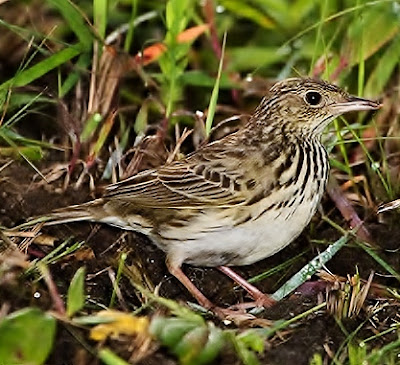 |
| Photo by Hugh Chittenden (Biodiversity Explorer) |
Common name:
short-tailed pipit (en); petinha-rabicurta (pt); pipit à queue courte (fr); bisbita colicorto (es); kurzschwanzpieper (de)
Taxonomy:
Order Passeriformes
Family Motacillidae
Range:
This African species is found from Gabon, through Congo, D.R. Congo and north-eastern Angola, and into Zambia. There are also separate populations in Tanzania, Uganda, Mozambique and South Africa.
Size:
These birds are 12 cm long and weigh around 16 g.
Habitat:
They are mostly found in short, wet grasslands, but also in dry grasslands, pastures and arable land. They occur from sea level up to an altitude of 1.800 m.
Diet:
Short-tailed pipits forage on the ground, eating seeds and both adult and larval insects.
Breeding:
In South Africa, these birds breed in October-February. The nest is an tidy cup made of dry grass and rootlets, placed on the ground next to flowering forbs, grass tufts or in tiny scrublets. The female lays 2-3 white eggs with brown and grey speckles, which are incubated for 13-14 days. The chicks fledge about 13 days after hatching.
Conservation:
IUCN status - LC (Least Concern)
The shirt-tailed pipit has a very large breeding range and is described as generally uncommon to frequent. The population is suspected to be stable in the absence of evidence for any declines or substantial threats.





No comments:
Post a Comment